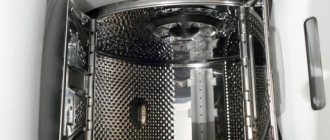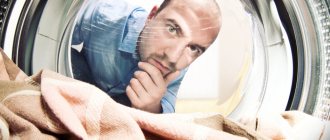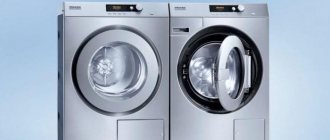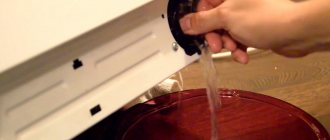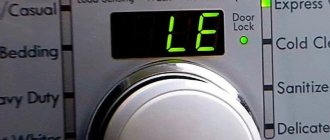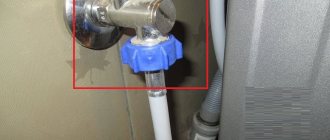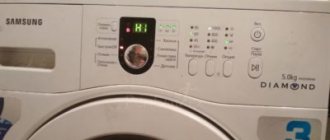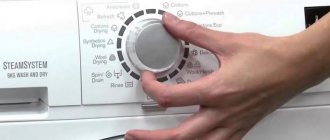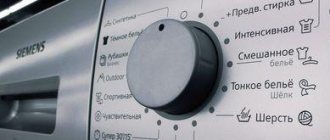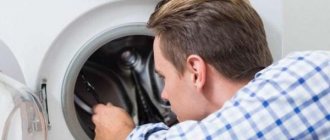You started the laundry, put the laundry in the washing machine, but things didn’t go any further - for some reason the door stopped closing... Most likely, you have already checked whether something has been “pinched” by the hatch. And they found nothing - visually everything was in perfect order. What could be the reason why the washing machine hatch does not close?
In fact, there may be several reasons. But they can be conditionally divided into two classes:
- mechanical damage - in this case the door does not lock at all, and you do not hear a characteristic click,
- or there are problems with the electronics - in this case, the door closes, you hear that the lock has worked, but the hatch does not lock, and you do not hear the second click that occurs when the hatch is closed electronically.
In the second case, modern machines often display an error on the display: after all, for the safety of both users and the home, an unlocked machine does not begin the operating cycle. If the hatch does not close even physically, then, of course, even the most ancient automatic car will not start.
However, you shouldn’t worry and look unkindly at a pile of dirty laundry. Let's try to figure out what exactly happened.
At the same time, both breakdowns – both mechanical and “electronic” – practically never happen, so we suggest that you immediately move on to the item that corresponds to your situation.
What to do if the washing machine door does not close
First of all, try to determine for yourself why the washing machine door does not close:
- Check to see if any laundry has gotten into the gap between the cabinet and the door. Carefully distribute the items throughout the drum and restart the program.
- Open the machine and carefully close the hatch, pressing firmly. Start the washing program, if there is a click, it means the door has closed.
- There may be a failure in the control module. Wait 10-15 minutes and only then turn on the wash again. Electronics are especially sensitive to power surges in the network, which is why failures occur.
- Check to see if any debris has gotten into the locking device slot. The UBL is located inside the housing. Sometimes it happens that debris gets into the groove where the door tongue should go. Blocking does not occur because the tongue does not reach the socket. This happens especially often if there are small children in the house. Small parts of construction toys, candy wrappers, or even chewing gum fall into the UBL.
Note! Often the washing machine does not close the door if you handle the equipment carelessly and do not follow the rules for its operation. Carefully check items before loading the drum, inspect pockets, and distribute laundry evenly throughout the drum.
"Aquastop" system
Some washing machines are equipped with a leak protection called AquaStop. This system is triggered when water appears on the SMA tray and prevents a new wash cycle from starting. Usually an error corresponding to this position is displayed.
Some brands, including Bosch and Siemens, equip the inlet hose with leakage protection. In this case, they talk about a complete “Aquastop”.
If such protection works, then you need to call a repairman and determine the cause. After all, a leak is an emergency.
In any case, it is necessary to open the machine body and dry the pan. If the error indicating a leak continues to be displayed, then it must be reset. Each brand does this differently. As a rule, this is described in the user manual.
Mechanical causes of failure
Mechanical failures usually consist of damage to the fastening and lock of the hatch. The reason is the natural wear of parts over time or careless handling, for example, the door is slammed hard when closing.
Skewed or damaged hinges
Check that the fasteners are tightly screwed on and that the door is level. On older models, the hinges may become warped over time; in new machines, the fastenings may suffer from external influences, for example, if you hang wet laundry on the door or drop a heavy object.
The metal lock rod fell out
The rod is responsible for the correct position of the tongue in the lock. Without it, the hook dangles, moves away from the groove, and the washing machine does not close the lock. If the rod is intact, the technician will install it in place, but often the lock has to be completely replaced.
Damage to the plastic guide
Such situations are rare, but they do happen. Some models of washing machines are equipped with plastic guides for closing the hatch. Over time, the plastic can become deformed, causing the hinges to sag. The hatch often closes, but not tightly.
Handle breakage
The plastic handles of the machine can suffer from rough handling or time. Children should not be allowed to play with the door or try to open the door before it is unlocked after the wash cycle has finished.
Note! External equipment breakdowns are easier to detect than internal ones, since they are often visible to the naked eye.
How to fix the situation
If the door does not close tightly, and after inspection you find that the tongue or guide is misaligned, you need to replace it.
- Unplug the washing machine.
- Using a screwdriver, unscrew the hinge screws and remove the door from the body.
- Place the door on a flat surface and begin disassembling. You first need to buy a repair kit for your model. Most likely, you will have to buy the entire pen, which includes a tongue.
- Unscrew the screws around the perimeter, release the latches and remove the inside of the door.
- Before disassembling the handle, take a photo of the location of the parts.
- Push and remove the pin, after which nothing will hold the parts.
- Reassemble the handle in reverse order, installing a new tab.
What should I do if the SMA display says that the door is not closed? This means the electronic lock is not working. Indicators on mechanical panels may flash. The UBL device needs to be replaced.
- Open the hatch door and unscrew the two bolts securing the device.
- Bend back the sealing rubber.
- Remove the clamp and tuck the cuff inside the drum.
- Take out the UBL device and disconnect the wiring from it.
Inspect the wiring. If burnt parts are visible, it needs to be replaced. The UBL is checked for resistance with a multimeter. If the lock is faulty, replace it in reverse order.
Electrical and electronic malfunctions of the washing machine, due to which the door may not close
If no problems are found with the door, you need to look for why the washing machine does not close in the washing machine itself. The reason may be due to malfunctions of individual parts:
UBL
In operating mode, voltage is supplied to the door lock lever after starting the washing program. Due to exposure to high temperatures, the bimetallic plates are heated and deformed, which force the lock latch to extend. The lever locks the door throughout the entire operating cycle of the machine.
After the program is completed, the power is removed from the UBL, the door remains locked for a few more minutes - this is time for the resistor to cool down and the bimetallic plates to return to their place.
Due to constant temperature changes, the bimetallic may become damaged over time. The plates stop deforming, as a result of which the lid of the washing machine does not close.
Control module
This is the main part of the equipment, without which it will not work. The control module issues commands and runs all modes and programs, including controlling the locking device. If the module is faulty, the UBL does not receive a signal, as a result of which the door does not lock and water does not enter the drum.
Damage to wiring or UBL contacts
Wires and contacts are damaged due to high humidity, vibration, voltage surges, and clogged filters. A characteristic sign is that the machine begins to shock, and the hatch does not lock. Damaged contacts need to be cleaned and soldered, weak ones need to be tightened.
Repairing the locking mechanism
If the door does not close tightly, then there is suspicion of deformation of the latch lever. More precisely, irregularities appear on the part, which prevent the hatch from being fixed in the locking mechanism. It's easy to fix the situation:
- remove the door according to the algorithm described above;
- unfold the hatch with the latch towards you;
- take a file and grind off all the existing nicks and irregularities;
- lubricate the surfaces with graphite lubricant for prevention;
- we return the door to its place.
When problems with closing the hatch are caused by sagging hinges or loose fasteners, you need to adjust the position of the door hinges. But here everything is determined by eye: we twist and tighten the fasteners until they fit completely into the grooves.
This is interesting: Why does the refrigerator click and crackle when turned on and running?
Conclusion
Self-repair is possible if the washing machine hatch does not close. But for this you need to have certain skills and understand the principle of operation of the technology. It is not difficult to fix minor mechanical damage, but in case of serious damage it is better to contact a specialist.
Finding a professional to repair your washing machine is easy with the help of the Tandem service. We have a large base of qualified craftsmen who work at customers’ homes. Call the service and we will quickly select a specialist.
How to solve problems with the electronic module
You figured out the lock of the washing machine, inspected it, and found no damage. How to determine that the cause of the malfunction is in the module:
- The door blocks, but does not erase.
- The “Lock” indicator does not light up on the display.
If any element or triac of the module burns out, then any part of the washing machine may fail. For example, a UBL may work properly, but the control unit does not recognize its signals. Or the triac of the fill valve is faulty, so water intake does not start.
Carefully inspect the board and its wiring at the time of scorching. Let's look at how to get to the module, but it is not recommended to repair it yourself.
- After disconnecting the SMA from the power supply, remove the top cover from the housing.
- Remove the dispenser tray by pressing the latch in the center.
- Remove the screws holding the control panel.
- Unlock the latches and detach the panel from the body.
- When disconnecting the wiring, inspect it for damage.
- To remove the board from the panel, you must also release the latches.
If you do not see any signs of damage, take the board to a service center. They will carry out professional diagnostics and repairs.
As you can see, some breakdowns can be fixed on your own. But there are situations when you cannot do without a specialist - do not take risks and entrust complex repairs to specialists.
Testing the UBL and changing it
But a door that does not close does not always require immediate replacement of the UBL. Before changing the blocker, you need to make sure that it is faulty. To evaluate the performance of the device, you will have to remove the device, inspect it and check it with a multimeter. We act like this.
- We disconnect the Indesit washing machine from all communications, including sewerage and water supply.
- We open the hatch. As a rule, if the mechanics worked perfectly, the door remains closed. Then we unlock it manually: unscrew the top cover, tilt the washer back, stick your hand to the lock and try to move the latch to the side with your index finger. You can proceed in a similar way from below, after first removing the bottom.
- Loosen the outer clamp on the cuff and tuck the elastic inside the drum.
- We find the lock, loosen the holding screws and take it out.
- Disconnect the wires connected to the UBL.
- We take out the UBL.
There is no need to try to repair a faulty UBL. Firstly, it is useless with disposable blocker parts. Secondly, the new device is inexpensive. In order not to make a mistake with the replacement, you need to tell the Indesit serial number in the store. Installation will not cause any difficulties: just act carefully, do not forget about safety precautions and follow the instructions described.
Examination
At home, you can only fully check the thermal UBL. To do this you need a Multimeter
(from the English multimeter),
tester
(from the English test - test),
avometer
(from the ampere-voltmeter) - a combined electrical measuring device that combines several functions.
The minimum set includes the functions of a voltmeter, ammeter and ohmmeter. Sometimes a multimeter is made in the form of a clamp meter. There are digital and analog multimeters.
"> multimeter, screwdriver (slotted or Torx - a type of slot of threaded fasteners in the shape of a six-pointed star. Registered trademark of Textron Fastening Systems (now Acument Global Technologies). The official name recorded in the ISO 10664 standard is hexalobular internal, in the Russian version GOST R ISO 10664-2007 - star-shaped recess for bolts and screws
.
Everyday names are star, asterisk, torx .
">torx) and an electrical extension cord.
First, pull the device out of the case. To do this, remove the collar from the cuff and pull back the edge next to the lock. Then unscrew the two screws that secure the lock to the body and pull it out. We pull off the chip. UBL is ready for diagnostics.
I work in the household appliance repair industry. Extensive experience in restoring washing machines and dishwashers.
Standard marking of thermal lock: N,L,C. A resistor passes through N and L. There is a certain resistance at these contacts. The remaining couples are broken up. If the contacts are numbered differently, you can tell by the resistance.
Another option is to connect the light bulb alternately to the terminal contacts, turn on the CMA and run the program. On the contacts that go to the resistor, the light will light up brightly.
To diagnose, we perform the following steps step by step:
- We supply 220 volts to contacts N and L using an extension cord.
- Use a screwdriver to move the moving part of the lock until it clicks. The latch should pop out. Thus, simulating the closing of the door. If there is no click and the moving part does not lock, then the lock is faulty and must be replaced.
- After 30-60 seconds, disconnect the UBL from the electricity.
- Using a multimeter, we measure the resistance between terminals C and L. It should be equal to 0. This means that the device is working. If it is broken, it needs replacement.
So, if point 2 did not work - there was no click and the moving part did not lock, then this means that one of the functions does not work and the lock is faulty. You don’t have to carry out further checking and buy a new UBL.
If, when performing step 4, the tester showed a broken connection, this means that another function of the lock does not work and replacement is necessary.
You should not experiment with trying to restore the device’s functionality. Thermal blockers cost 300-900 rubles, depending on the brand, model and greed of the parts supplier.
Buying a used lock is a very controversial decision. This will lead to a recurrence of problems; in addition, you need to understand that a burnt, worn lock can lead to damage to the electronic module. And these are other expenses.
Examination
At home, you can only fully check the thermal UBL. To do this you need a Multimeter
(from the English multimeter),
tester
(from the English test - test),
avometer
(from the ampere-voltmeter) - a combined electrical measuring device that combines several functions.
The minimum set includes the functions of a voltmeter, ammeter and ohmmeter. Sometimes a multimeter is made in the form of a clamp meter. There are digital and analog multimeters.
"> multimeter, screwdriver (slotted or Torx - a type of slot of threaded fasteners in the shape of a six-pointed star. Registered trademark of Textron Fastening Systems (now Acument Global Technologies). The official name recorded in the ISO 10664 standard is hexalobular internal, in the Russian version GOST R ISO 10664-2007 - star-shaped recess for bolts and screws
.
Everyday names are star, asterisk, torx .
">torx) and an electrical extension cord.
First, pull the device out of the case. To do this, remove the collar from the cuff and pull back the edge next to the lock. Then unscrew the two screws that secure the lock to the body and pull it out. We pull off the chip. UBL is ready for diagnostics.
I work in the household appliance repair industry. Extensive experience in restoring washing machines and dishwashers.
Standard marking of thermal lock: N,L,C. A resistor passes through N and L. There is a certain resistance at these contacts. The remaining couples are broken up. If the contacts are numbered differently, you can tell by the resistance.
Another option is to connect the light bulb alternately to the terminal contacts, turn on the CMA and run the program. On the contacts that go to the resistor, the light will light up brightly.
To diagnose, we perform the following steps step by step:
- We supply 220 volts to contacts N and L using an extension cord.
- Use a screwdriver to move the moving part of the lock until it clicks. The latch should pop out. Thus, simulating the closing of the door. If there is no click and the moving part does not lock, then the lock is faulty and must be replaced.
- After 30-60 seconds, disconnect the UBL from the electricity.
- Using a multimeter, we measure the resistance between terminals C and L. It should be equal to 0. This means that the device is working. If it is broken, it needs replacement.
So, if point 2 did not work - there was no click and the moving part did not lock, then this means that one of the functions does not work and the lock is faulty. You don’t have to carry out further checking and buy a new UBL.
If, when performing step 4, the tester showed a broken connection, this means that another function of the lock does not work and replacement is necessary.
You should not experiment with trying to restore the device’s functionality. Thermal blockers cost 300-900 rubles, depending on the brand, model and greed of the parts supplier.
Buying a used lock is a very controversial decision. This will lead to a recurrence of problems; in addition, you need to understand that a burnt, worn lock can lead to damage to the electronic module. And these are other expenses.
